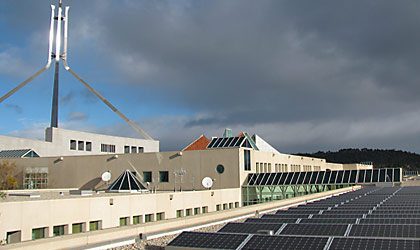The ACT government has called for tenders for the first round of contracts to build up to 40MW of large scale solar facilities in the territory, with the winners of the first tender to be announced in July.
The ACT is the first government in Australia to introduce a feed in tariff for large scale renewables, and will set the price via an auction, where competing projects bid against each other to establish the cheapest and most credible project.
The auction is expected to generate huge interest among solar developers because there are no other mechanisms which encourage the deployment of utility-scale solar in the country, and the various grants based programs introduced by the Federal Government, including the Solar Flagships program, appear to be at a standstill.
The ACT had previously proposed its own grants-based program, but decided to change this to a 20-year feed-in-tariff after noting the success of such schemes overseas. More than 80 countries around the world now have such tariffs, and some key countries have been using a similar auction system, which they argue is the most effective mechanism of setting a fair price, without the need for constant reviews to match the fall in technology costs.
India is using this system for its National Solar Mission to install 22GW by 2022, and which has seen bids fall by more than half in the last two years – to the point where they are now only 25 per cent above bids for new coal fired plants – and the auction system is being used in Brazil, where wind projects have won major contracts by bidding below rival gas generation.
The ACT auction is designed to have at least two projects, but could end up with more, depending on the size of the winning tenders. Among those likely to bid are the local utility ACT Actew, which had previously proposed a 22MW solar PV plant near Williamsdale, which it would use as part of its commitment to deliver renewable energy to electric vehicle network operator Better Place, which will launch its first Australian network in Canberra later this year.
However, a host of other projects ranging in size from 2MW to 20MW are expected to compete. Many of these will include some of the 52 companies that lodged interest in the flagships tender, and will be keen for a smaller scale project to demonstrate their technology. It is will likely be based around solar PV technologies, because they are far cheaper than solar thermal technologies. Industry experts expect most projects to be in the 3MW to 15MW bracket.
Bids for the first round of 20MW close in April with the winner or winners to be announced in July this year. The remainder to be awarded after a second auction in April next year.
The 40MW will account for around 2 per cent of the ACT electricity needs, and forms a key part of its renewable energy usage targets of 15 per cent by 2012 and 25 per cent by 2020. The ACT has ambitions to become the nation’s “solar capital”, and given the paucity of other developments around the country – only one other large scale renewable project is currently under construction, the 10MW Greenough plant in Western Australia – it may be a title it can claim – even without the best solar resources.
However, it says much about the state of solar in Australia that in a nation with the world’s best solar resource, and the best R&D, 40MW should be so prominent in a year when more 30,000 megawatts of solar – nearly half of it utility scale – will be installed around the world. China is likely to install 3,000MW of large scale solar alone in 2012.
The ACT’s Minister for Environment and Sustainable Development, Simon Corbell, says the tender process will ensure that Canberra gets the best value for its renewable technology.
He said the government will shortlist proposals based on those with the best capacity and track record to deliver the projects before inviting pricing offers. A seminar for prospective bidders will be held on February 10.
Most states in Australia, including the ACT, have wound back feed in tariffs for rooftop solar, and the Federal Government has resisted calls to introduce a national tariff, or a tariff for large scale renewables, as some have suggested. It argues tht the Renewable Energy target is sufficient, although its newly proposed Clean Energy Finance Corporation will likely provide different mechanisms for emerging technologies.
“Having a feed-in tariff on the table for industry is essential to give the industry investment certainty, that will in turn see Canberra’s plan to become Australia’s solar capital a reality,” Corbell said in a statement.
“Having large scale solar in the ACT will assist in reducing carbon emissions beyond the national targets and take advantage of the large reductions in the cost of solar energy that has recently occurred in Australia.”







